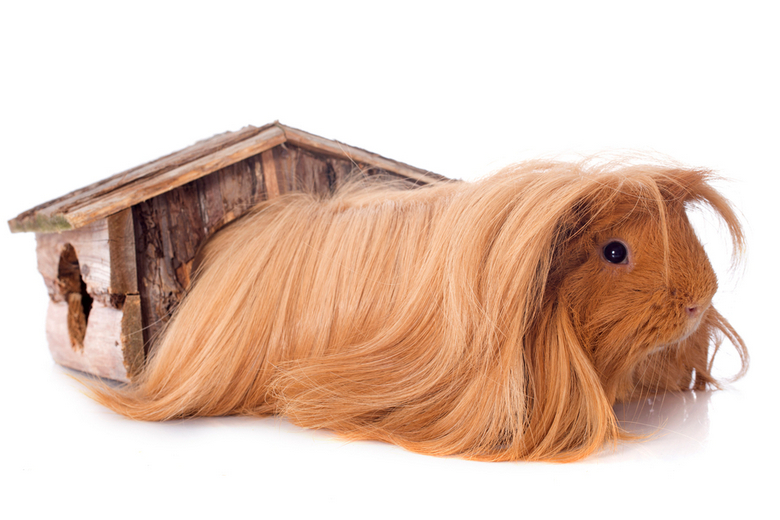Guinea pigs surely come in many presentations and colors, and it is one of the reasons that makes them a wonderful pet choice. You can pick just the perfect guinea pig for you! Peruvian guinea pigs, in particular, are all about the fabulous hair. Here at Pet Comments, we share some facts and information of interest concerning the Peruvian guinea pig.

Facts and Information
Location
As you can probably guess Peruvian guinea pigs come from Peru! That, however, is not their only home. The Peruvian “cuy” (as is called in Peru) can be found in other parts of South America, like Brazil, Bolivia, and Argentina.
Lifespan
This beautiful guinea pig breed can live from 6 to 8 years. In the wild they can have a shorter lifespan due to the harshness of nature, but their endurance and longevity in captivity will totally depend on the care and love they receive from their caring owners.
Size
Guinea pigs have an approximate size of 10 to 12 inches yet some can be larger than that!
Hair
The trademark of the Peruvian is definitely the hair. Often confused with the Silkie, the Peruvian guinea pig has long, even hair. They can be marked, tricolor, bicolor, agouti or solid colors. The long hair of the Peruvian breed can reach 20 inches long. Their hair needs constant and daily brushing to avoid tangles.
A few things that can differentiate a Silkie from a Peruvian is the length of the hair, the Peruvian hair is the longest. Also, it grows evenly, if the owner doesn’t do regular trims to the Peruvian’s hair they will have a ball of hair running around not knowing where is the front and where is the back of their guinea pig. Doing this will also help you keep things clean and tidy (you won’t like to find food in your Peruvian’s hair!)
Luckily enough, this is what scissors exist for! Regular trims can keep your pet from tripping on their own feet. Bonus points if you can manage to make your guinea pig look cooler than it is!
Health
Like any other Guinea pig, Peruvian guinea pigs are prone to several health issues. Since guinea pigs can’t synthesize vitamin C, scurvy is a major problem; therefore, they need to get enough vitamin C through their diet. Other health issues involve lice infestation and diarrhea.
Surpassingly enough, the Peruvian guinea pig’s hair is also a reason of concern. They renew their coats in spring and fall, but their heavy coats become a real problem in the warmer months of the year. For this reason, Peruvian guinea pigs are prone to “heat stress” thus, is essential for the owner to remain alert to the weather conditions and how will it affect their guinea pig.
Food& Diet
The Peruvian guinea pig’s diet is really not different from the other guinea pigs. This means there isn’t anything in particular that Peruvians guinea pigs eat that others guinea pigs doesn’t. Because of their vitamin C deficiency, they need plenty of it. Guinea pigs don’t subsist on timothy hay alone; they need greens, healthy treats and pellets specially designed for guinea pigs. A rich and varied diet is the way to go with them.
Guinea pigs are herbivores, hence, don’t give them anything that remotely contains meat, processed food or sweets. Remember one common problem with these buddies is diarrhea, and a good diet is crucial to avoid it.

Behavior
As social as Guinea pigs are, social grooming is a must! Unfortunately, because of the length of their hair, they can’t groom the same way other guinea pigs do. Since most Guinea pigs have short hair, what they do is to lick and clean each other.
Peruvian guinea pigs have their own way of grooming called barbering. They chew the hair of other Guinea pigs, removing it in the processes. Is believed that Peruvian guineas do this when they lack other items to chew. Many chew the hair in the front of the head of another guinea pig making their vision easier; this could possibly be their way of maintaining their vision in the wild.
With their owners, Peruvians “cuy” are cuddlesome and love to spend time with them. Like other breeds of guinea pigs, is best to keep them in pairs considering how social they are.
Know the Differences!
The Silkie guinea pig and the Peruvian guinea pig share the very distinctive trade of long marvelous hair. However, an experienced owner would never confuse one with the other. The silkie guinea pig’s hair grows like the mane of a lion, from the back of their head backward, leaving their front open. While the mane of the Peruvian grows with long bangs of hair that in most cases completely covers their adorable faces. Making it hard to see where the head and the tail are.
The Peruvian’s hair coat is longer than the silkie and it has a natural part in the middle of their back, which the Silkie guinea pig completely lacks.
Is this the Guinea Pig for You?
As pretty as they are, and lovely because what Guinea pig is not adorable? Peruvian guinea pigs are not for rookies owners. These babies need constant attention and care. So, if you lack the time to spend in your Peruvian guinea pig, or if you have small children that could harshly handle the little furry friend then is better to abstain from buying a Peruvian guinea pig.
However, if you have the time, the wish and the will to watch and care for a Peruvian guinea pig, you may prepare yourself for lots of love from your new friend and the stares of people in awe for such beautiful hair.
Further readings and references:
- UFAW, Peruvian - Long Hair
- Alderton D (2001) The ultimate encyclopedia of small pets and pet care. Lorenz books: London ( Find This Book )